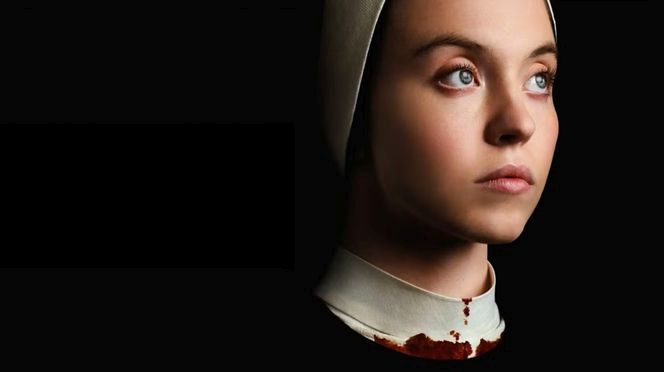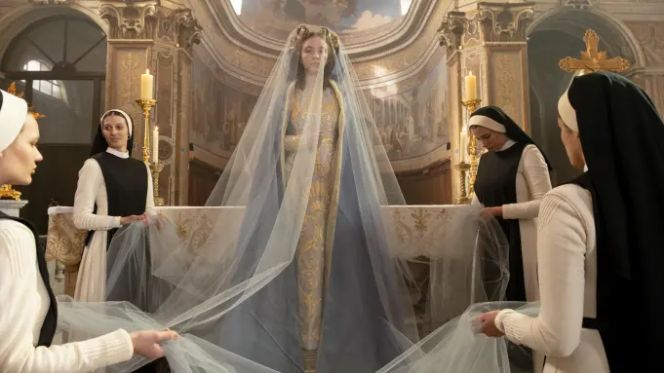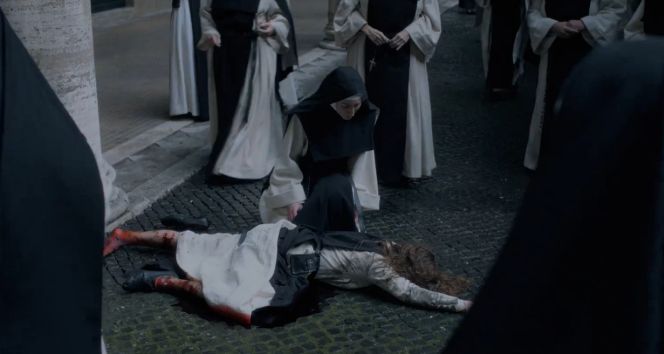MOVIE REVIEW – Immaculate wanders in the shadow of faith, dissecting the faded allure of religious horror films and controversies surrounding the Catholic Church. The narrative centers around a young woman enduring astonishing trials. Immaculate does not shy away from conventional horror elements but boldly tackles questions related to gender roles, religious doctrines, and the scars left by sexual abuse. Despite Sydney Sweeney’s fluctuating performance and the eerie monastery shrouded in mist, Immaculate strives to infuse the religious horror genre with new content, though it often stumbles into the genre’s clichéd pitfalls.
Religious horror films once unleashed waves of terror, but their impact has dulled over time. The 1970s, propelled by The Exorcist, reignited America’s belief in the existence of the devil, leading to higher church attendance compared to today. Immaculate, Neon’s latest film focusing on Catholicism, captures this trend by prompting its heroine, following her hometown parish’s closure, to move to Italy and become a nun. A rather radical decision, but why not? The film also sheds light on a potential reason for the decline in the faith of Catholic believers when Sister Gwen (Benedetta Porcaroli) inquires if “usual priestly issues” (sexual abuses) led to the closure of Sister Cecilia’s (Sydney Sweeney) church.
Sexual Abuses Reloaded
Cecilia, despite her innocent soul, is aware of Gwen’s implication but firmly states that it wasn’t the case for her. Thus, the film doesn’t evade the Catholic Church’s sexual abuse issues, albeit handling them in a cautious manner typical of horror films, as is the case with handling real-life atrocities. This film doesn’t focus on possession unless considering the oppression of women’s reproductive rights by patriarchal and bigoted religious systems (as highlighted in the 2020 HBO documentary, Baby God) as a form of demonic influence. An intriguing thought, yet Immaculate’s narrative follows the safest possible course, surrounded by traditional, slowly building horror clichés.
The movie starts with a chilling opening scene where black-robed figures chase a fleeing nun across a foggy courtyard, then shifts focus to Cecilia, who has just arrived at the Convent of the Sorrowful Mother, hoping to dedicate her life to the Church. Father Tesdeschi (Álvaro Morte), a former geneticist and distractingly handsome for a priest, supports her in this quest. On the night of her novitiate ceremony, Cecilia shares with Father Tesdeschi a near-death experience she had at the age of twelve, believing God saved her for a purpose, hoping to find it at the convent. Indeed, she does, in a way.
Rural Idyll vs. Gothic Horror
The convent’s atmosphere balances between rural tranquility and dark gothic elements. The nuns spend their days hanging laundry and tending to the sick in a verdant, idyllic valley built over an ancient catacomb. The beauty of the place is enhanced by the cloudy sky and the warm orange light of candles. Death becomes “part of everyday life” in the convent, as stern Sister Mary (Simona Tabasco) remarks to Cecilia. Yet, this is not enough to instill fear in Cecilia – after all, Catholicism leans towards morbidity, as demonstrated by the devout veneration of a long nail allegedly pulled from Christ’s hand. However, the screams in the courtyard and the sight of nuns in red, form-fitting, eerie garments should, at the very least, raise some red flags, right?
Cecilia’s slow awakening to the disturbing reality that something perverse and dark operates within the convent walls is a critical weakness of the film. It takes too long for the narrative to pick up pace and unfold genuine tension. Sweeney’s performance could use more nuance and depth; at most intense moments, only tears well up in her eyes, and her lips quiver, like when the nuns dress her in the Virgin Mary’s garb for a mystical ceremony. While captivating, this alone is insufficient, and only in the film’s final stages does Sweeney’s portrayal become truly compelling.
Bold Twist at the End
Immaculate’s bold finale compensates for the earlier parts’ clichéd nature, and as the story unfolds, Cecilia finally finds courage from her desperation, prompting Sydney Sweeney to pull herself together and deliver a committed, blood-soaked, surprisingly impressive performance. However, this twist comes too late. Director Michael Mohan primarily relies on loud noises and deep, resonating musical scores to frighten viewers, a tactic that, while seemingly effective on paper, leaves many other promising ideas and elements underexplored. Such missed opportunities include the chilling setting, the emergence of new talent in the lead role, the finer nuances of the horror genre, mysterious figures gliding through dark corridors, or dolls made of hair.
In theory, Immaculate possesses all the elements needed for a successful religious horror film: a captivating setting, a rising star in the lead role, a disconcerting storyline, and spooky visual elements. Although the film’s visual and auditory presentation is impressive, the plot too frequently relies on jump scares, and Sweeney’s performance doesn’t reach the intensity that would make her and the film truly memorable until it’s too late.
- -Gergely Herpai (BadSector)-
Immaculate
Direction - 6.2
Actors - 6.5
Story - 6.2
Horror/Scare Factor - 7.2
Ambience - 6.8
6.6
FAIR
Sydney Sweeney’s venture into a sinister Italian convent in Immaculate starts off strong and holds potential but quickly loses momentum and struggles to regain strength in time to convincingly deliver its grave, audacious ending.




![SkyShowtime Presents the Stylish Trailer for the Spy Thriller Series PONIES [VIDEO]](https://thegeek.games/wp-content/uploads/2025/12/theGeek-A-ket-poni-302x180.jpg)










![SkyShowtime Presents the Stylish Trailer for the Spy Thriller Series PONIES [VIDEO]](https://thegeek.games/wp-content/uploads/2025/12/theGeek-A-ket-poni-300x365.jpg)

